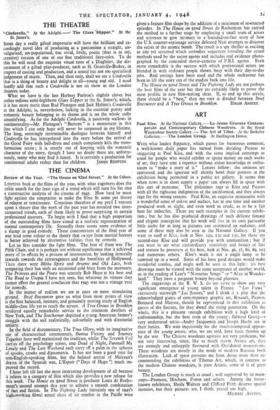ART
Paul Klee. At the National Gallery.—La Jeune Gravure Contem- porain and Contemporary Chinese Woodcuts. At the Royal Watercolour Society Gallery.— The Art of Tibet. At the Berkeley Galleries.—The London Group. At Burlington House.
WITH what leaden flippancy, which passes for humorous comment, a well-known daily paper has turned from deriding Picasso to sniggering at Paul Klee, and with the same implied contempt as usual for people who would exhibit or spend money on such works . of art, they have sent a reporter without either knowledge or enthu- , siasm to " make a story of it." Letters follow : the eminent are canvassed, and the ignorant will shortly howl their protests at the exhibition being permitted in a public art gallery. It seems that when news is in short supply a paper can always fill in space with this sort of nonsense: The philistines rage at Klee and Picasso with all the righteous indignation of the uninformed, and they always rage for the wrong reasons. Paul Klee, an exquisite miniaturist with a wonderful sense of colour and surface, has at one time and another produced work so slight, and even work so crude, as to be a fair butt for imbeciles. There are such examples in the current exhibi- tion ; but he has also produced drawings of such delicate fantasy and elegant conception that his work will live in its own particular little niche for as long as pictures can command an audience, and . some of these may also be seen at the National Gallery. If you want to scoff at Kl.te, look at Nos. 120, 130 and 131, for these are second-rate Klee and will provide you with ammunition ; but if you want to see what extraordinary sensitivity and beauty of line and texture he possesses at his best, look at Nos. 46, 57, 8o, 89, 103 and numerous others. Klee's work is not a single lump to be • summed up in a word. Some of his least good designs would make wonderful textiles, and might well be seen in this light: his best drawings must be viewed with the same acceptance of another world, • as in the reading of Lear's " Nonsense Songs '.or " Alice in Wonder- land." They have a poignant beauty beyond pleasure.
The engravings at the R. W. S. do not serve to show any very significant emergence of young talent in France. "Les Vieux" excessively outweigh "Les Punes," and I think it a pity that the acknowledged giants of contemporary graphic art, Rouault, Picasso, Bonnard and Matisse, should be represented in this exhibition as guests of the Society, for they dwarf the rising generation. On the whole, this is a pleasant enough exhibition with a high level of craftsmanship, but the best even of the young ; Edward Goerg—a very underrated artist—Andre Jacquemin and Joseph Hecht are in their forties. We wait impatiently for the much-trumpeted appear- ance of the young artists, who, we are told, have been thrown up _ by the war. The Chinese woodcuts upstairs are very proficient, but not very interesting, since, like so much recent Asiatic art, they are strongly and unhappily flavoured with Occidental mannerisms. These woodcuts are mostly in the mode of modern Russian book illustration. Lack .of space prevents me from doing more than re- commending the exhibition of Tibetan Art, which, in contrast to the modem Chinese woodcuts, is pure Asiatic, some of it of great beauty.
The London Group is much as usual ; well suppbrted by its main- stays—Pasmore, Hitchens, Fitton and others. Among the lesser- known exhibitors, Sheila Walters and Clifford Frith deserve special mention, but their pictures are, I think, priced too high.
MICHAEL AYRTON.































 Previous page
Previous page